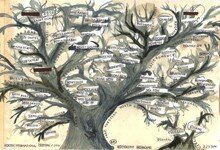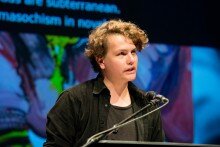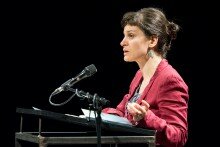“Taking liberties”: the translator’s approach to Rachel
How a middle-class Russian Jewish woman became a Hebrew poet while writing in a style reminiscent of A.E. Houseman.
Rachel Bluwstein, known by her pen name, Rachel, was born on September 20, 1890, in Saratov, a little town in northern Russia. Beginning her education in a Jewish elementary school, she went on to study in a Russian high school, where her courses included classes in sketching and painting, for which she showed great aptitude, and classes in Russian literature, which inspired her, at the age of 15, to write poetry.
In 1909 she came to Palestine as a tourist, intending to go on to visit Europe before she returned to her well-to-do-home in Russia, but soon she changed her plans radically. Her tour of Palestine started out with a stay of several months in Rehovot, then a small community, where some members of her family had settled. Here she gave herself up to a study of Hebrew, of the Bible especially. Rehovot was followed by a visit, first to the Arab town of Jaffa, which enchanted her; then to a number of settlements, where she was deeply impressed and moved by the settlers’ dedication to their socialist Zionist ideals. Inspired by Chana Meisel, an instructor in agriculture, whom she had met in the settlement of Sajera, and who was to become a lifelong friend and a powerful influence. she joined a small kibbutz– Kinneret – on the shores of the sea of Galilee. She chose this kibbutz principally because it had an agricultural school for young women. It was here she met A.D. Gordon, perhaps the philosopher of labor, and dedicated to him the first poem she wrote in Hebrew.
She had for some time been devoting herself to painting, less so to poetry, but she decided that in Eretz-Israel her first priority must be working the land. Rather than practicing drawing or music, she would say that one should ”paint with the soil and play with the hoe.” True to this new dedication, Rachel became one of the best workers of her kibbutz, which was remarkable in light of the fact that she came from an upper middle-class family, and that her life up to then had been an easy, even a luxurious one. Her father, although he had been compelled to serve in the Tsar’s army for 25 years, had made a fortune in business. Her mother, highly cultured, presided over a salon, and Rachel’s many brothers and sisters were all highly educated and some highly talented as well. A tall, aristocratic-looking and very beautiful woman, Rachel made a remarkable figure as she worked tirelessly in the fields. It was a hard life, the working hours were long, and the kibbutz offered only primitive facilities, but she was physically very strong and utterly dedicated. In her later years she was to think of her years at this kibbutz as the happiest of her life.
She left Palestine in 1913 to study agriculture at Toulouse University, but on her way there she stopped for some months in Italy to study aquarelle. At Toulouse she continued her agricultural studies and managed to get her degree in spite of the Great War. But the war made it impossible for her to get back to Palestine, so she returned to Russia, where she taught children of Jewish refugees. It was a time of hard work and hunger, and she began to show the first signs of the TB that was eventually to kill her. Yearning for her beloved land, she was, in 1919, on the first post-war ship taking immigrants to Eretz-Yisrael.
On her return she joined Degania Aleph, another kibbutz on the Sea of Galilee, but her stay there was short. Her now fully developed TB made her unfit for the life of the soil, and she was compelled to leave. Though she hated urban life, she went to live in Tel Aviv. Later she moved to Jerusalem, where she spent her last years in loneliness, and was often hospitalized.
She had many relationships with men, but never married. (She has even been described as the femme fatale of the second and third [waves of Russian immigration to Palestine].) One of the most important of these relationships has only recently come to light, with the discovery in a library of a batch of her papers. Among these are love letters written to her during 1915-1923 by a young Russian Jew named Michael Berelstein. These letters reveal that their relationship had taken place during two of the years she lived in France, from 1913 till 1915, and that they were still in touch long after they had separated. Together with the letters, the batch contained poems to Berelstein, written (significantly) in Russian.
She died on April 16, 1931, at the age of 41, and was buried by the sea she celebrated. Her grave has become a place of pilgrimage where the “pilgrim” can find in a stone container next to her poems a book of her poems.
Rachel had only began writing poetry seriously in her 29th year. Encouraged by Davar, and the writers who collected around that famous newspaper, she wrote articles and feuilletons for it as well. She oon had written enough poetry to produce several books, eventually collected in The Poems of Rachel, from which the poems in this selection have been translated.
The translation of her poetry involves a number of special problems. This is true, of course, of any poet. To create a translation, to find for an original poem an incarnation equivalent in its diction and idiom, in tone, resonance and music, calls for a translator who is also a poet – one who, paradoxical as it may seem, achieves fidelity by being true to his or her own style. It cannot be emphasized too much that the result must be a true poem if it is to be of any use at all. A literal rendition in prose is far preferable to a poetic one that, although following for instance the original rhyme scheme, the original word order, does not come across as a poem in its own right.
Whatever the problems faced by the translator of Rachel, they are the problems presented by a very fine poet of beautiful (and deceptive) simplicity, and of a mastery of word and phrase that bring Houseman strikingly to mind. That very simplicity and mastery make seemingly effortless and inevitable poetry (the ballad, the song) more difficult to translate than poetry of a more ambitious kind.
Like Houseman’s, her poems are limited in themes. “I have only known how to tell of myself,” she wrote, but her limitations are more than compensated for by a depth of feeling that though powerful is always under control. She needed a great deal of control, since what Yeats says tellingly of Houseman is also true of her: one step further and all had been marsh. But she rarely took that step, resisting the sentimentality that her themes opened her up to; for these dealt mainly with aspects of failed love, with her longing for happiness, and with her illness and poverty. Though the poems express rare moments of happiness, they mainly reflect despair, desperation, and nostalgia for those long ago days when she worked on the land.
Though Rachel can be described as old-fashioned, it must be remembered that she was also in some ways surprisingly modern. She was among the first to rebel against the pretentious, pompously heroic diction popular in her time, bringing to Hebrew verse a quite revolutionary freshness and modesty of language that relied for its effects on the colloquial. Quite in keeping with modern expectations is her preoccupation with “small” subject. She is indeed strongest when she relies on closely observed detail, whether domestic or otherwise, i.e. “a cradle in a corner covered with white sheets”, “tiny joys, joys like a lizard’s tail”, “the sick heart galloping like a horse”, “the cow’s warm breathing”, and so on.
There are two characteristics of Rachel’s poetry that raise difficulties for the translator: the regularity of her metres, and her occasional lapses in her use of a colloquial idiom. The translator’s sensibility must overcome these difficulties in the interest of contemporary expectations. The particular musicality of Rachel’s poems (many of them have been set to music and frequently sung) is often best rendered by taking discriminating liberties, by the substitution, say, of iambs for the anapests that she, under the influence of Russian verse, especially Akhmatova’s, relied on a good deal. Anapests go far too trippingly in English. As regards rhyme (though rhyme is a staple of many of these translations), it is better not to rhyme at all than to stick zealously to a musical pattern that requires syntactic wrenching and imprecision of word or phrase.
The translator, too, must sometimes tone down what mars Rachel’s otherwise simple diction, the resort to abstractions characteristic of the writing of her time – her over-use of such words as ‘happiness’, ‘pain’, ‘toil’, ‘hope’, ‘poverty’ and the like, though their use cannot, of course, be avoided altogether. I found as well that the deletion and addition of words found in the original sometimes proved helpful. In my translation of ‘Jonathan’, for example, where the original’s last line reads “a little taste of honey” I have added the words “in the mouth” – an addition justified by the need to provide a rhyme at the very end which would allow the poem to end with a full sound instead of weakly trailing off. On the other hand, in “Take in a clasp of brotherhood…” it was deletion – the words “my dear and only one” at the end of line 5 in the original that helped, paradoxically, to assure fidelity.
It should be pointed out that at the time Rachel was writing, predominantly in the twenties, Hebrew had become once more a language spoken in the streets. For millennia it had served mainly for the transmission of religious history, tradition, and law (the Bible, Mishna and Talmud). The language had been resuscitated in the late 19th century as a result of the Zionist movement and the reestablishment of Jewish life in Palestine beyond the small circle of ultra-religious settlement. But when it came to the expression of this now mainly secular life, writers found that they did not have a vocabulary adequate to their purposes. They were limited by the traditional literary language at their disposal and had not yet assimilated the colloquial, which itself took time to develop. It was Rachel, perhaps owing in part to her lack of a strong religious background, who take the first steps towards this accommodation. In this, she brilliantly succeeded.
From Robert Friend’s introduction to his Flowers of Perhaps: Selected Poems of Ra’hel London: Menard Press, 1994
Copyright © Jean Shapiro Cantu







